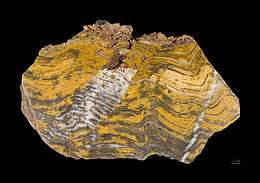Paleoarchean
The Paleoarchean (/ˌpeɪlioʊɑːrˈkiːən/), also spelled Palaeoarchaean (formerly known as early Archean), is a geologic era within the Archaean Eon. It spans the period of time 3,600 to 3,200 million years ago—the era is defined chronometrically and is not referenced to a specific level of a rock section on Earth. The name derives from Greek "Palaios" ancient. The oldest ascertained life form of fossilized bacteria in microbial mats, 3,480 million years old, found in Western Australia, is from this era.[1][2] The first supercontinent Vaalbara formed during this period.
| Paleoarchean Eon 3600–3200 million years ago | |
-4500 — – -4000 — – -3500 — – -3000 — – -2500 — – -2000 — – -1500 — – -1000 — – -500 — – 0 — |

During this era, a large asteroid, about 37 to 58 kilometres (23–36 mi) wide, collided with the Earth in the area of South Africa about 3.26 billion years ago, creating the features known as the Barberton greenstone belt.[3]
References
- Borenstein, Seth (13 November 2013). "Oldest fossil found: Meet your microbial mom". AP News. Retrieved 15 November 2013.
- Noffke, Nora; Christian, Daniel; Wacey, David; Hazen, Robert M. (8 November 2013). "Microbially Induced Sedimentary Structures Recording an Ancient Ecosystem in the ca. 3.48 Billion-Year-Old Dresser Formation, Pilbara, Western Australia". Astrobiology. 13 (12): 1103–24. doi:10.1089/ast.2013.1030. PMC 3870916. PMID 24205812. Retrieved 15 November 2013.
- “Scientists reconstruct ancient impact that dwarfs dinosaur-extinction blast”, American Geophysical Union, April 9, 2014